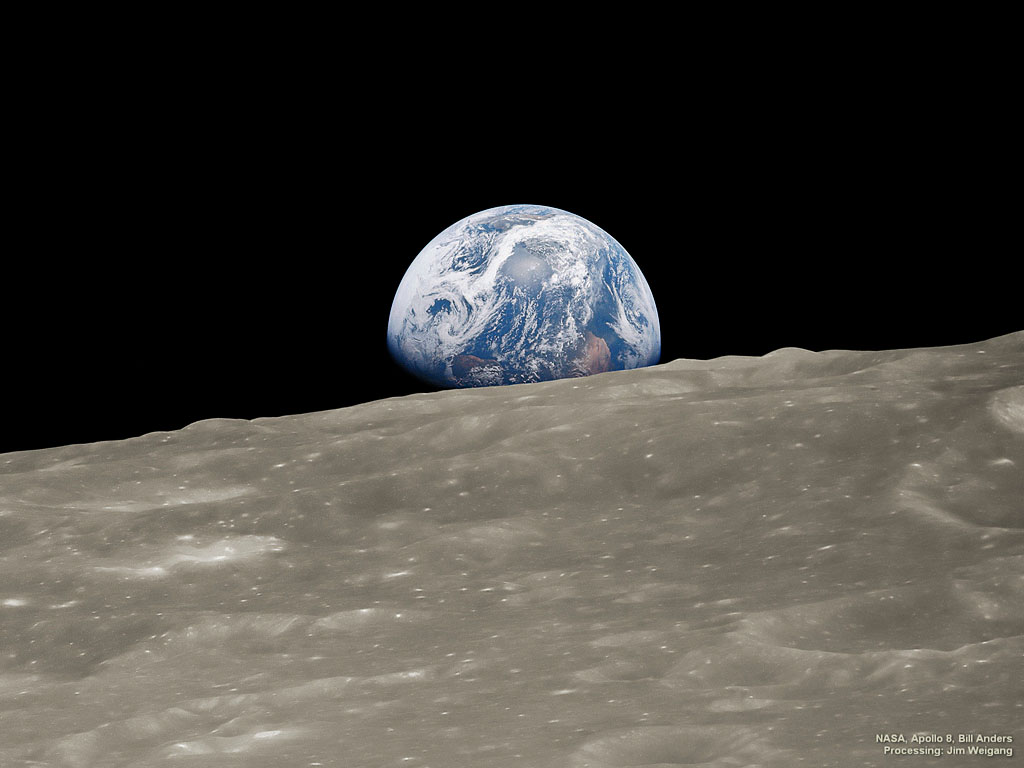Life changed for many of us a little over 50 years ago, when the crew of the Apollo 8 mission captured images of Earth rising over the Moon’s horizon. It was not the first time that Earth had been photographed from far away, but it was the first time it was photographed from a “place” far away – something that gave it context. Perhaps it was the contrast of Earth’s color and dynamic weather against the Moon’s barren gray surface, but whatever it was, it changed us. We could recognize Earth as our home, and see that it was beautiful – and alone in a vast expanse of empty Space. The above image is a reconstruction of that original image. The primary objective of this reconstruction, I think, was to combine the best features of 2 separate images taken that day. You see, the first photograph was taken just like this, with Earth on the Moon’s horizon, but it was a monochrome (black & white) photo. The color photo that most people saw and remembered was taken later, when Earth was well above the horizon.
As we approach the end of 2018, I’m thinking back on all the changes at Wa-chur-ed Observatory – and changes that are coming up in 2019. The biggest change in the past year has been my use of the remote observatory in Australia. In addition to opening the window to a whole new set of deep-space objects, this arrangement has allowed me to use better equipment than the gear I own. Indeed, it is better equipment than I could afford to own! I hope you have enjoyed seeing these images from the southern hemisphere.
Perhaps not entirely unrelated to my use of the remote observatory, I did not do nearly as much local astrophotography this year. Processing the images from Australia took up a fair amount of time, but probably more than that it took away the pressure on me to capture more images locally. I also changed a lot of my gear in 2018, and not always with immediate success, so that impeded my efforts to capture images locally. It was actually in late 2017 that I acquired the William Optics FLT-132 that is now my primary telescope. It worked great right from the beginning, although it took a while to fit it with a PerfectStar B focus control system. Some months ago I wrote about the Paramount MyT mount I acquired, but it is only very recently that I got it working properly. It’s a long, sad story, so I won’t burden you with the details, but the bottom line is that the people at Software Bisque (the manufacturer of Paramount mounts) were absolute heroes in resolving the issues, and I am now very happy with the mount.
One of the hottest trends in astrophotography today is the rise of high performance CMOS cameras. Historically, astrophotographers used cameras based on CCD (charge-coupled device) sensors almost exclusively, while consumer grade digital cameras switched largely to CMOS sensors. This was because CCDs produced less noisy images, while the main advantage to CMOS was lower cost. But CMOS technology was able to make dramatic improvements, while CCDs improved at a much more modest pace. There are significant differences in how these technologies are best used, so we are still far from having the entire industry taken over by CMOS cameras. I recently joined the CMOS cadre, having purchased an ASI1600MM, which is a 16 megapixel monochrome camera. Its sensor is roughly the same size as the QSI683 camera I have been using for years, but it has twice as many pixels, so they are smaller pixels. I will be keeping the QSI camera – at least for a while, as it will probably be better for some purposes. The most immediate difference in switching from CCD to CMOS is that you get better results by taking a larger number of sub-exposures, with each exposure being of shorter duration. This might mean using about the same total integration time, but having to deal with a larger number of image files to produce the finished image.
My next blog post here will be from southern California. You might call it a working vacation, as I plan to do a lot of astrophotography (both capturing and processing images), but since that is what I enjoy doing, I’m thinking of it as a vacation. Most importantly, I will enjoy the warmth and sunshine of living in the desert – a very welcomed change from the weather here at home. It will take a while to get down there, and then I’m hoping to take advantage of the New Moon next week, so it may be a while before my next post, but I’ll try to make it worth the wait!
Happy New Year from Wa-chur-ed!
